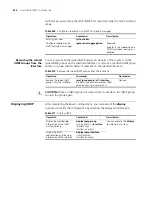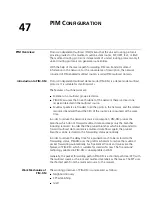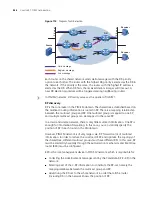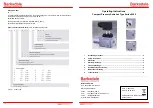
452
C
HAPTER
46: IGMP C
ONFIGURATION
Enhancements Provided by IGMPv2
Compared with IGMPv1, IGMPv2 provides the querier election mechanism and
Leave Group mechanism.
■
Querier election mechanism
In IGMPv1, the DR elected by the Layer 3 multicast routing protocol (such as PIM)
serves as the querier among multiple routers on the same subnet.
In IGMPv2, an independent querier election mechanism is introduced. The querier
election process is as follows:
1
Initially, every IGMPv2 router assumes itself as the querier and sends IGMP general
query messages (often referred to as general queries) to all hosts and routers on
the local subnet (the destination address is 224.0.0.1).
2
Upon hearing a general query, every IGMPv2 router compares the source IP
address of the query message with its own interface address. After comparison,
the router with the lowest IP address wins the querier election and all other
IGMPv2 routers become non-queriers.
3
All the non-queriers start a timer, known as “other querier present timer”. If a
router receives an IGMP query from the querier before the timer expires, it resets
this timer; otherwise, it assumes the querier to have timed out and initiates a new
querier election process.
■
Leave group” mechanism
In IGMPv1, when a host leaves a multicast group, it does not send any notification
to the multicast router. The multicast router relies on IGMP query response timeout
to know whether a group no longer has members. This adds to the leave latency.
In IGMPv2, on the other hand, when a host leaves a multicast group:
1
This host sends a Leave Group message (often referred to as leave message) to all
routers (the destination address is 224.0.0.2) on the local subnet.
2
Upon receiving the leave message, the querier sends a configurable number of
group-specific queries to the group being left. The destination address field and
group address field of message are both filled with the address of the multicast
group being queried.
3
One of the remaining members, if any on the subnet, of the group being queried
should send a membership report within the maximum response time set in the
query messages.
If the querier receives a membership report for the group within the maximum
response time, it will maintain the memberships of the group; otherwise, the
querier will assume that no hosts on the subnet are still interested in multicast
traffic to that group and will stop maintaining the memberships of the group.
IGMP Proxy
A lot of leaf networks (leaf domains) are involved in the application of a multicast
routing protocol (PIM-DM for example) over a large-scaled network. It is a hard
work to configure and manage these leaf networks.
To reduce the workload of configuration and management without affecting the
multicast connection of leaf networks, you can configure an IGMP Proxy in a Layer
Summary of Contents for Switch 7757
Page 32: ...32 CHAPTER 1 CLI OVERVIEW...
Page 70: ...70 CHAPTER 5 LOGGING IN USING MODEM...
Page 76: ...76 CHAPTER 7 LOGGING IN THROUGH NMS...
Page 86: ...86 CHAPTER 9 CONFIGURATION FILE MANAGEMENT...
Page 120: ...120 CHAPTER 13 ISOLATE USER VLAN CONFIGURATION...
Page 126: ...126 CHAPTER 14 SUPER VLAN...
Page 136: ...136 CHAPTER 16 IP PERFORMANCE CONFIGURATION...
Page 152: ...152 CHAPTER 17 IPX CONFIGURATION...
Page 164: ...164 CHAPTER 19 QINQ CONFIGURATION...
Page 172: ...172 CHAPTER 21 SHARED VLAN CONFIGURATION...
Page 182: ...182 CHAPTER 22 PORT BASIC CONFIGURATION...
Page 198: ...198 CHAPTER 24 PORT ISOLATION CONFIGURATION...
Page 208: ...208 CHAPTER 25 PORT SECURITY CONFIGURATION...
Page 224: ...224 CHAPTER 27 DLDP CONFIGURATION...
Page 232: ...232 CHAPTER 28 MAC ADDRESS TABLE MANAGEMENT...
Page 240: ...240 CHAPTER 29 CENTRALIZED MAC ADDRESS AUTHENTICATION CONFIGURATION...
Page 280: ...280 CHAPTER 30 MSTP CONFIGURATION...
Page 348: ...348 CHAPTER 35 IS IS CONFIGURATION...
Page 408: ...408 CHAPTER 39 802 1X CONFIGURATION...
Page 412: ...412 CHAPTER 40 HABP CONFIGURATION...
Page 422: ...422 CHAPTER 41 MULTICAST OVERVIEW...
Page 426: ...426 CHAPTER 42 GMRP CONFIGURATION...
Page 480: ...480 CHAPTER 47 PIM CONFIGURATION...
Page 506: ...506 CHAPTER 48 MSDP CONFIGURATION...
Page 552: ...552 CHAPTER 51 TRAFFIC ACCOUNTING CONFIGURATION...
Page 570: ...570 CHAPTER 53 HA CONFIGURATION...
Page 582: ...582 CHAPTER 54 ARP CONFIGURATION SwitchA arp protective down recover interval 200...
Page 622: ...622 CHAPTER 58 DHCP RELAY AGENT CONFIGURATION...
Page 684: ...684 CHAPTER 61 QOS CONFIGURATION...
Page 718: ...718 CHAPTER 63 CLUSTER...
Page 738: ...738 CHAPTER 67 UDP HELPER CONFIGURATION...
Page 752: ...752 CHAPTER 69 RMON CONFIGURATION...
Page 772: ...772 CHAPTER 70 NTP CONFIGURATION...
Page 796: ...796 CHAPTER 72 FILE SYSTEM MANAGEMENT...
Page 802: ...802 CHAPTER 73 BIMS CONFIGURATION...
Page 814: ...814 CHAPTER 74 FTP AND TFTP CONFIGURATION...
Page 830: ...830 CHAPTER 75 INFORMATION CENTER...
Page 836: ...836 CHAPTER 76 DNS CONFIGURATION...
Page 852: ...852 CHAPTER 77 BOOTROM AND HOST SOFTWARE LOADING...
Page 858: ...858 CHAPTER 78 BASIC SYSTEM CONFIGURATION DEBUGGING...
















































